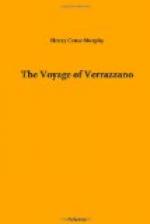This intention is made positively certain by the remark which follows the statement of the latitude, that “beyond this point the Portuguese had already sailed as far north as the Arctic circle without coming to the termination of the land.” The exploration of the Portuguese here referred to, and as far as which that of Verrazzano is carried, was made by Gaspar Cortereal in his second voyage, when according to the letter of Pasqualigo the Venetian embassador, he sailed from Lisbon on a course between west and northwest, and struck a coast along which he ran from six to seven hundred miles, “without finding the end.” [Footnote: Paesi novamente ritrovati. Lib. sexto. cap. CXXXL. Venice, 1521. A translation into English of Pasqualigo’s letter, which is dated the 19th of October, 1501, is given in the memoir of Sebastian Cabot, p. 235-6.] No other exploration along this coast by the Portuguese, tending to the Arctic circle is known to have taken place before the publication of the Verrazzano letter. The first voyage of Cortereal, was, according to the description of the people given by Damiam de Goes, among the Esquimaux, whether on the one side or the other of Davis straits it is unnecessary here to inquire, as the Esquimaux are not found south of 50 Degrees N. latitude. The land along which he ran in his second voyage, was, according to the same historian, distinctly named after him and his brother, who shared his fate in a subsequent voyage. It is so called on several early printed maps on which it is represented as identical with Newfoundland. It appears first on a map of the world in the Ptolemy of 1511 edited by Bernardus Sylvanus of Eboli, and is there laid down as extending from latitude 50 Degrees N. to 60 Degrees N. with the name of Corte Real or Court Royal, latinized into Regalis Domus. [Footnote: Claudii Ptholemaei Alexandrini liber geographiae, cum tabulis et universali figura et cum additione locorum quae a recentioribus reporta sunt diligenti cura emendatus et impressus. (Fol., Venetiis, 1511.)] The length of the coast, corresponds with the description of Pasqualigo, and its position with the latitude assigned by the Verrazzano letter for their exploration. Its direction is north and south. There can be no question therefore as to the pretension of the Verrazzano letter to the discovery of the coast by him, actually as far north as the fiftieth parallel.
That it is utterly unfounded, so far as regards that portion of the coast lying east and north of Cape Breton, that is, from 46 Degrees N. latitude to 50 Degrees N., embracing a distance of five hundred miles according to actual measurement, or eight hundred miles according to the letter, is proven by the fact, that it had all been known and frequented by Portuguese and French fishermen, for a period of twenty years preceding the Verrazano voyage. The Portuguese fisheries in Newfoundland must have commenced shortly after the voyages of the brothers Cortereaes in 1501-2,




